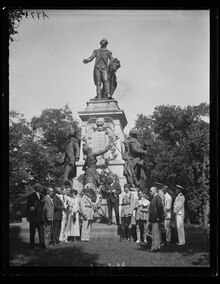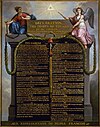
Marius Jean Antonin Mercié, was a French sculptor, medallist and painter.

Marshal Jean-Baptiste Donatien de Vimeur, comte de Rochambeau was a French nobleman and general whose army played a critical role in helping the United States defeat the British Army at Yorktown in 1781 during the American Revolutionary War. He was commander-in-chief of the French expeditionary force sent by France to help the American Continental Army fight against British forces.
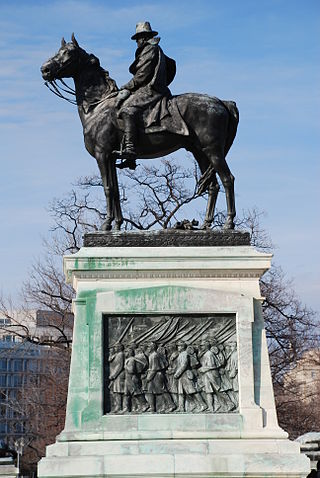
The Ulysses S. Grant Memorial is a presidential memorial in Washington, D.C., honoring American Civil War general and 18th president of the United States, Ulysses S. Grant. It sits at the base of Capitol Hill, below the west front of the United States Capitol. Its central sculpture of Grant on horseback faces west, overlooking the Capitol Reflecting Pool and facing toward the Lincoln Memorial, which honors Grant's wartime president, Abraham Lincoln. Grant's statue is raised on a pedestal decorated with bronze reliefs of the infantry; flanking pedestals hold statues of protective lions and bronze representations of the Union cavalry and artillery. The whole is connected with marble covered platforms, balustrades, and stairs. The Grant and Lincoln memorials define the eastern and western ends, respectively, of the National Mall.

Lafayette Square is a seven-acre public park located within President's Park in Washington, D.C., directly north of the White House on H Street, bounded by Jackson Place on the west, Madison Place on the east and Pennsylvania Avenue on the south. It is named for the general, the Marquis de Lafayette, a French aristocrat, and hero of the American Revolutionary War (1775–1783) and includes several statues of revolutionary heroes from Europe, including Lafayette, while at its center is a famous statue of early 19th century U.S. president and general Andrew Jackson on horseback with both of the horse's front hooves raised.

Lieutenant General George Washington is an 1860 equestrian statue of George Washington, at Washington Circle, at the edge of the George Washington University's campus, in Washington, D.C. The statue was sculpted by Clark Mills, who also created the equestrian statue of Andrew Jackson in front of the White House. The traffic circle where the statue is located was one of the original city designs by Pierre Charles L'Enfant. The statue and surrounding park are in the Foggy Bottom neighborhood at the intersection of 23rd Street, New Hampshire Avenue, and Pennsylvania Avenue NW. The K Street NW underpass runs beneath the circle.

Andrew Jackson is a bronze equestrian statue by Clark Mills mounted on a white marble base in the center of Lafayette Square within President's Park in Washington, D.C., just to the north of the White House. Jackson is depicted dressed in military uniform, raising his hat with his right hand, while controlling the reins with his left hand as his horse rises on its rear legs.
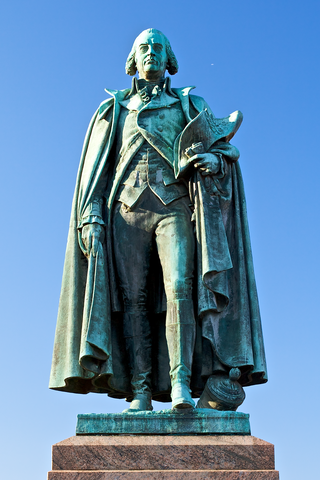
General Artemas Ward is a bronze statue of American Revolutionary War general Artemas Ward. It is sited in the center of Ward Circle, which was specifically made for the statue, at the intersection of Nebraska and Massachusetts Avenue in the American University Park neighborhood of Washington, D.C. The 10-foot (3.0 m) statue of Ward was completed in 1936, but was not unveiled for two years. Ward was the first Commander-in-Chief of colonial forces during the Revolutionary War and served in a number of government roles, including as representative to the United States House of Representatives.

Brigadier General Thaddeus Kościuszko is a bronze statue honoring Polish military figure and engineer Tadeusz Kościuszko. The sculpture was dedicated in 1910, the third of four statues in Lafayette Square, Washington, D.C., to honor foreign-born heroes of the American Revolutionary War. Born in the Polish–Lithuanian Commonwealth in 1746, Kościuszko later received education at a Jesuit school before attending the Corps of Cadets in Warsaw. He later traveled to France where he studied in military academy libraries and adopted views of human liberty during the Age of Enlightenment. He moved to the Thirteen Colonies in 1776, where the war with the Kingdom of Great Britain had already begun. Kościuszko served as an engineer in the Continental Army, earning the praise of his superiors, including General George Washington.

Major General Comte Jean de Rochambeau is a bronze statue honoring Jean-Baptiste Donatien de Vimeur, comte de Rochambeau, a French nobleman and general who played a major role in helping the Thirteen Colonies win independence during the American Revolutionary War. Rochambeau joined the French military as a teenager, participating in the War of Austrian Succession, after which he was promoted to colonel, and the Seven Years' War. During the war in America, Louis XVI asked Rochambeau to lead a force of 5,500 French soldiers to assist the fight against the Kingdom of Great Britain. He and George Washington later worked together in the successful siege of Yorktown. He led the Army of the North during the French Revolutionary Wars, but was arrested and almost executed during the Reign of Terror. His military rank was restored by Napoleon and Rochambeau died a few years later in 1807.

Major General Friedrich Wilhelm von Steuben is a bronze statue of Friedrich Wilhelm von Steuben, a Prussian soldier who assisted the Thirteen Colonies during the American Revolutionary War. Steuben had fought in previous wars, earning promotions until he assisted in the courts of Frederick the Great and later Josef Friedrich Wilhelm, Prince of Hohenzollern-Hechingen. After meeting with Benjamin Franklin, and fearing for his safety in Europe after alleged homosexual behavior, Steuben and his associates arrived to help the Continental Army.

The statue of John Barry commemorates the "Father of the United States Navy", Commodore John Barry (1745-1806). Barry was an Irish-born sailor who joined the American colonists in fighting for independence from the Kingdom of Great Britain. Barry became the first commission by the Second Continental Congress. He captained several ships during the war, and not only fought in the Continental Navy, but also the Continental Army. He was the first American to capture an enemy ship and was promoted to commodore by President George Washington in 1794. Barry's last ship, the United States, fought in the Quasi-War. He retired in 1801, but remained head of the United States Navy until his death in 1806.

Major General Nathanael Greene is a bronze equestrian statue honoring Nathanael Greene, a military leader during the American Revolutionary War. Greene was from modern-day Rhode Island and after laws passed by the Kingdom of Great Britain, along with the burning of one of his ships, Greene formed a state militia. He was later promoted to brigadier general in the Continental Army where he became a trusted adviser to Commander-in-Chief General George Washington. Greene played an active role during the war, participating in battles, sieges, and campaigns from New England to the Southern Colonies. For his service to the war, Greene was offered free land and settled in Georgia with his family. He died a few years later from a heatstroke.

The outdoor statue of Benjamin Franklin in Washington, D.C., is located near the intersection of 12th Street and Pennsylvania Avenue, in front of the Old Post Office. The statue was a gift from Stilson Hutchins, founder of The Washington Post, who wanted to display his and the newspaper's stature in the city. The designer, Ernst Plassmann, and sculptor, Jacques Jouvenal, were both German-American artists. The architect of the memorial was J. F. Manning.

General Casimir Pulaski is a bronze equestrian statue of Casimir Pulaski, a military man born in the Polish–Lithuanian Commonwealth. He joined the military at a young age, fighting for removal of the king, who was backed by Russia. After his side lost the war, he fled to Paris, where he met Benjamin Franklin. Impressed by Pulaski, Franklin wrote a letter of recommendation to George Washington, suggesting he would be a helpful soldier during the American Revolutionary War. After arriving in the U.S., Pulaski eventually was promoted to Brigadier General and commanded a cavalry unit, the Pulaski's Legion. He died in 1779 due to injuries sustained in battle.

American Revolution Statuary is a group of fourteen statues in Washington, D.C., which honor men whose actions assisted the Thirteen Colonies in their fight against the Kingdom of Great Britain in the American Revolutionary War. They are spread throughout the city, except for the four statues in Lafayette Square, across from the White House, that honor some of the foreign heroes from the war. Some of the statues are located in prominent places, while others are in small parks or stand alone in front of buildings. All of the statues are owned and maintained by the National Park Service, an agency of the United States Department of the Interior. The statuary was collectively listed on the National Register of Historic Places (NRHP) in 1978 and the District of Columbia Inventory of Historic Sites the following year. In addition, most are also contributing properties to historic districts listed on the NRHP.

Marquis de Lafayette is an outdoor bronze sculpture of Gilbert du Motier, Marquis de Lafayette by artist Frédéric Auguste Bartholdi, located at Union Square Park in Manhattan, New York.

Gilbert du Motier, Marquis de Lafayette (1757–1834), a French aristocrat and Revolutionary War hero, was widely commemorated in the U.S. and elsewhere. Below is a list of the many homages and/or tributes named in his honor:

Marquis de Lafayette is a monumental statue on the campus of Lafayette College in Easton, Pennsylvania. The statue, designed by Daniel Chester French and standing on a pedestal designed by Henry Bacon, was dedicated in 1921 in honor of the college's namesake, Gilbert du Motier, Marquis de Lafayette. The statue is located at the south entrance of Colton Chapel. It is one of a number of sculptures made by French for universities, which includes the statue of John Harvard at Harvard University and Alma Mater at Columbia University.
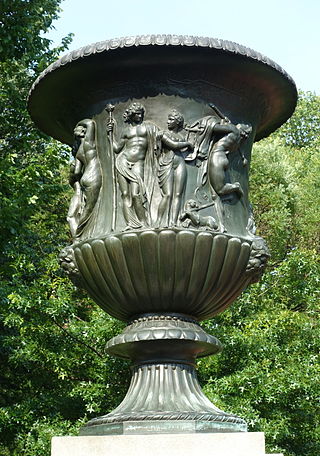
The Navy Yard Urns are two decorative bronze urns located in Lafayette Square, a small park across the street from the White House, in Washington, D.C. They were originally planned to be installed in the 1850s, but due to the Civil War and other events, they were not erected until 1872. Secretary of the Navy George M. Robeson had ordered the urns be made at the Washington Navy Yard using melted cannons from the Civil War.


